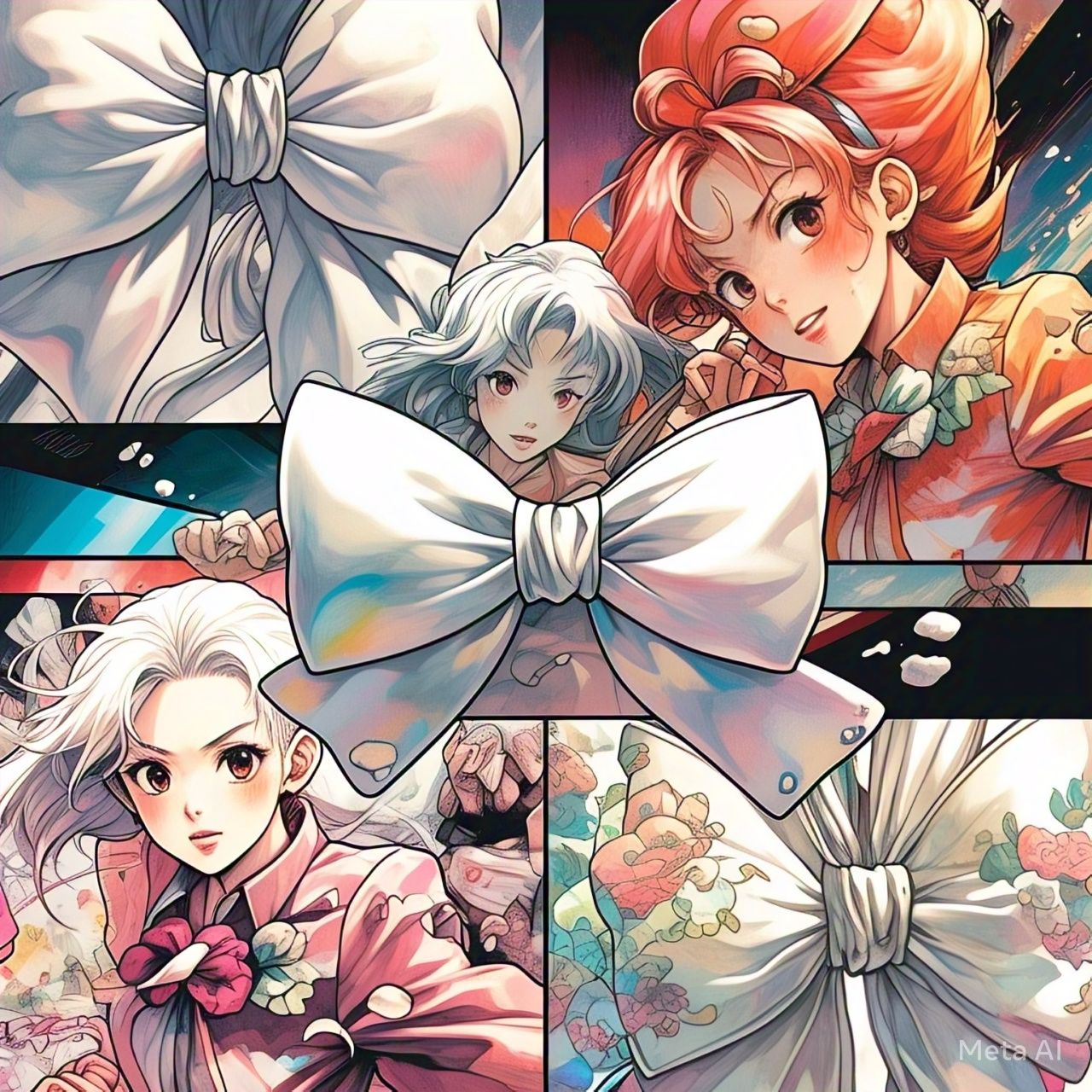The Origins and Early History of the White Hair Bow
The Birth of a Timeless Accessory
The white hair bow has long been a symbol of elegance, innocence, and sophistication. Its origins can be traced back centuries, emerging as a practical yet decorative accessory before evolving into a fashion statement. In the early days, hair bows were not merely ornamental—they served functional purposes, keeping hair in place while adding a touch of refinement to everyday wear.
During the Renaissance period, ribbons and bows became popular among European nobility. Women of high social standing adorned their elaborate hairstyles with silk ribbons, often in white, symbolizing purity and wealth. The white hair bow, in particular, gained prominence as a marker of femininity and grace.
The Victorian Era: A Symbol of Modesty and Elegance
The Victorian era (1837–1901) marked a significant turning point in the history of the white hair bow. Fashion during this time was deeply influenced by societal norms, with women expected to present themselves with modesty and decorum. The white hair bow became a staple in women’s hairstyles, often paired with intricate updos and ringlet curls.
Queen Victoria herself was known for her conservative yet elegant style, and her influence trickled down to women across all social classes. The white bow, made from fine materials like lace and satin, was seen as a mark of respectability. Young girls also wore smaller versions, reinforcing the association between white bows and youthful innocence.
The Rise of the Hair Bow in Early 20th Century Fashion
As the 20th century dawned, fashion began to shift toward more practical and liberated styles. However, the white hair bow retained its popularity, adapting to new trends. The Gibson Girl look, characterized by voluminous hairstyles topped with large bows, became iconic in the 1900s.
Silent film stars of the 1920s further cemented the white bow’s place in fashion. Actresses like Mary Pickford and Clara Bow wore them both on and off-screen, making the accessory a symbol of Hollywood glamour. The bow was no longer just a sign of modesty—it was now a statement of charm and sophistication.
The early history of the white hair bow reveals its deep roots in culture and fashion. From its practical beginnings in the Renaissance to its symbolic role in the Victorian era and early Hollywood, the bow has continuously evolved while maintaining its timeless appeal. The next part will explore how mid-20th century fashion trends transformed the white hair bow into a versatile and enduring accessory.
The Mid-20th Century Reinvention of the White Hair Bow
The Golden Age of Hollywood and the Hair Bow
The mid-20th century saw the white hair bow take on new life as Hollywood’s leading ladies embraced it as a signature look. Stars like Audrey Hepburn and Grace Kelly often wore white bows in films and public appearances, solidifying their association with elegance and femininity.
In the 1950s, the bow became a key element of the “coquette” aesthetic—soft, romantic, and polished. Women paired white bows with victory rolls and bouffant hairstyles, creating a look that was both glamorous and refined. The bow was no longer just an accessory; it was a defining feature of a woman’s ensemble.
The Influence of Youth Culture in the 1960s and 1970s
As fashion trends shifted in the 1960s, the white hair bow adapted to fit the changing times. Youth-driven styles, such as the mod and hippie movements, influenced how women wore bows. While some opted for minimalist, sleek versions, others embraced oversized, dramatic bows as a form of self-expression.
The 1970s brought a bohemian twist to the white hair bow. Flowy, ethereal styles dominated the decade, and bows were often made from crochet or gauzy fabrics. This era demonstrated the bow’s versatility, proving it could transcend different fashion movements while remaining a beloved accessory.
The White Bow in Professional and Everyday Wear
By the late 20th century, the white hair bow had also found its way into professional settings. Women in corporate environments incorporated subtle bows into their hairstyles, balancing professionalism with a touch of femininity. Meanwhile, schoolgirls and young women continued to wear them as a nod to classic, preppy fashion.
The mid-20th century was a period of reinvention for the white hair bow. From Hollywood starlets to rebellious youth culture, the bow adapted to each new trend while maintaining its charm. The next section will explore how modern fashion has reinterpreted this classic accessory, blending vintage inspiration with contemporary style.
The White Hair Bow in Late 20th Century Rebellion and Revival
The Punk Era: Subverting Tradition
The 1980s and 1990s witnessed a dramatic transformation in fashion, where traditional symbols were often reimagined through countercultural movements. The white hair bow, once a hallmark of prim femininity, was appropriated by punk and alternative scenes as a statement of ironic contrast. What had previously signified innocence now became a tool for rebellion, with musicians and subcultures deliberately juxtaposing the delicate accessory with edgy aesthetics.
Punk icons like Debbie Harry of Blondie and Siouxsie Sioux incorporated white bows into their looks, pairing them with leather jackets, ripped fishnets, and bold makeup. This unexpected styling challenged conventional notions of femininity, proving that even the most traditional accessories could be repurposed for radical self-expression. The bow’s crisp whiteness against punk’s dark palette created a striking visual tension that resonated with youth culture.
Preppy Resurgence and the Bow’s Return to Mainstream
While punk was deconstructing the bow’s meaning, another cultural force was brewing—the 1980s preppy revival. Fashion took a sharp turn toward polished, collegiate-inspired looks, with designers like Ralph Lauren and Tommy Hilfiger reintroducing classic elements like the white hair bow into mainstream wardrobes. This time, however, it was styled with a contemporary twist: larger proportions, luxurious fabrics, and a more relaxed approach to traditional femininity.
Teen movies of the era, such as Pretty in Pink and Sixteen Candles, featured protagonists who wore white bows as part of their signature looks. These characters embodied a blend of youthful innocence and burgeoning independence, making the bow a symbol of transitional girlhood. Meanwhile, pop stars like Madonna and Cyndi Lauper experimented with bows in their music videos, further cementing the accessory’s place in 80s pop culture.
Minimalism and the Bow in 1990s Fashion
The 1990s brought a stark shift toward minimalism, with designers like Calvin Klein and Jil Sander stripping away excess ornamentation. Yet, even in this pared-down landscape, the white hair bow endured—albeit in subtler forms. Thin, understated silk ribbons became a quiet signature of 90s sophistication, often seen in sleek updos or half-up hairstyles.
Supermodels like Kate Moss and Naomi Campbell occasionally wore delicate white bows on runways and in editorial shoots, proving that the accessory could adapt to the decade’s “less is more” philosophy. At the same time, the rise of grunge introduced another subversive take, with some styling bows in deliberately messy, undone ways—a far cry from their pristine Victorian origins.
The Bow as a Cultural Signifier
By the late 20th century, the white hair bow had accumulated layers of meaning. It could signify nostalgia for vintage glamour, a nod to preppy tradition, or a wink at punk’s rebellious spirit. Its versatility allowed it to appear in unexpected contexts, from riot grrrl zines to high-fashion editorials.
This period also saw the bow transcend gender norms, with male musicians like Prince and Boy George incorporating ribbons and bows into their flamboyant stage personas. The accessory’s fluidity hinted at its potential for even broader reinvention in the coming decades.
The White Hair Bow in Contemporary Fashion and Beyond
The Modern Resurgence of a Classic Accessory
In the 21st century, the white hair bow has experienced a dramatic revival, proving that some fashion trends never truly fade. What was once a symbol of vintage elegance has been reinterpreted by modern designers, influencers, and pop culture icons. Today, the white hair bow is no longer confined to a specific era—it is a versatile statement piece that blends nostalgia with contemporary style.
Social media platforms like Instagram, TikTok, and Pinterest have played a significant role in the bow’s resurgence. Fashion influencers and celebrities have embraced the accessory, showcasing it in various ways—from dainty, minimalist styles to exaggerated, avant-garde designs. The white bow has become a staple in the “coquette” and “old money” aesthetics, reinforcing its association with timeless sophistication.
High Fashion and the White Hair Bow
Luxury fashion houses have also contributed to the bow’s modern evolution. Designers such as Simone Rocha, Miu Miu, and Vivienne Westwood have incorporated oversized white bows into their runway looks, transforming them into high-fashion art pieces. These designs often play with proportions, textures, and materials, pushing the boundaries of how a hair bow can be perceived.
In recent years, the white bow has appeared in editorial spreads and red-carpet events, worn by celebrities like Florence Pugh, Zendaya, and Emma Corrin. These appearances highlight the accessory’s adaptability—it can be sweet and romantic, bold and dramatic, or even edgy and subversive, depending on how it is styled.
The White Bow in Streetwear and Subcultures
Beyond high fashion, the white hair bow has also found a place in streetwear and alternative subcultures. The rise of “e-girl” and “dark academia” fashion has led to creative reinterpretations of the bow, often paired with contrasting elements like leather, chains, or grunge-inspired outfits. This juxtaposition of soft femininity with edgy aesthetics demonstrates the bow’s versatility.
Additionally, the bow has become a symbol of empowerment and self-expression. Many wearers today choose it not just for its aesthetic appeal but as a deliberate nod to vintage femininity, reclaiming it as a statement of confidence rather than conformity.
Sustainability and the Future of the White Hair Bow
As the fashion industry shifts toward sustainability, the white hair bow has also evolved in terms of materials and production. Many brands now offer bows made from upcycled fabrics, organic cotton, or biodegradable materials, aligning with eco-conscious consumer values. DIY culture has also contributed to this trend, with tutorials on repurposing old fabrics into handmade bows gaining popularity.
Looking ahead, the white hair bow is likely to remain a beloved accessory, continuously adapting to new trends while maintaining its classic charm. Whether through high-fashion reinventions, streetwear adaptations, or sustainable innovations, the bow’s journey is far from over.
Conclusion: A Timeless Icon in Ever-Changing Fashion
From its origins in Renaissance Europe to its modern-day reinventions, the white hair bow has proven its staying power. It has transcended generations, social norms, and fashion revolutions, always finding a way to remain relevant. Today, it stands as more than just an accessory—it is a cultural symbol, a fashion statement, and a testament to the cyclical nature of style.
As trends continue to evolve, one thing is certain: the white hair bow will keep adapting, inspiring, and captivating wearers for years to come. Its journey from vintage staple to modern must-have is a reminder that true style is timeless.










